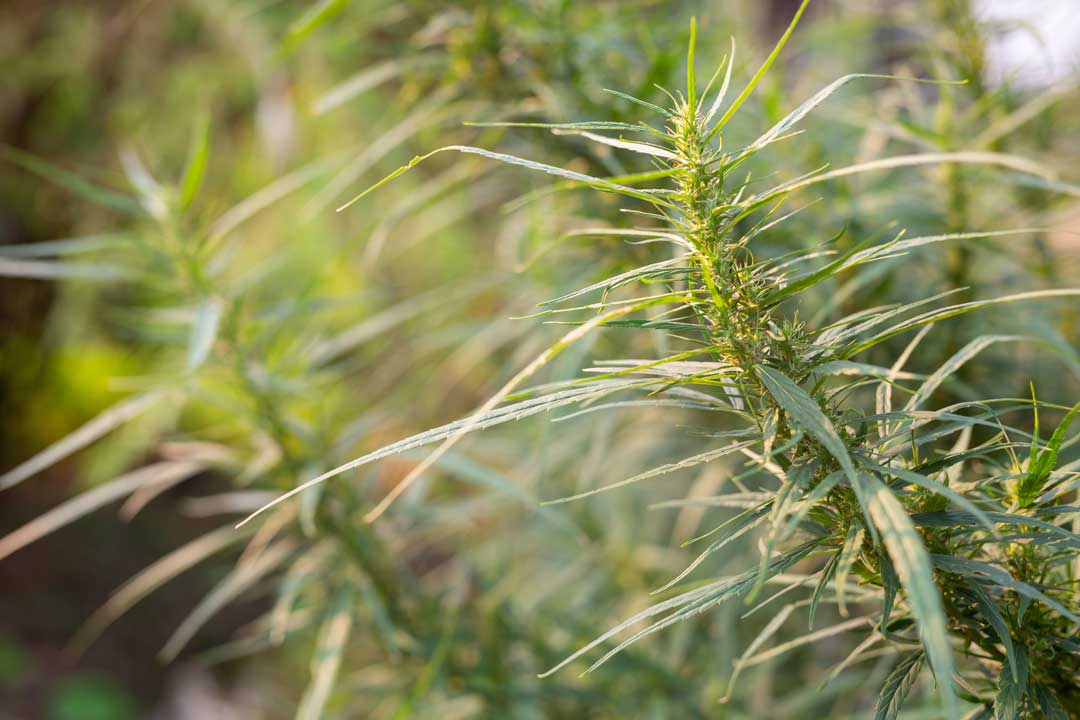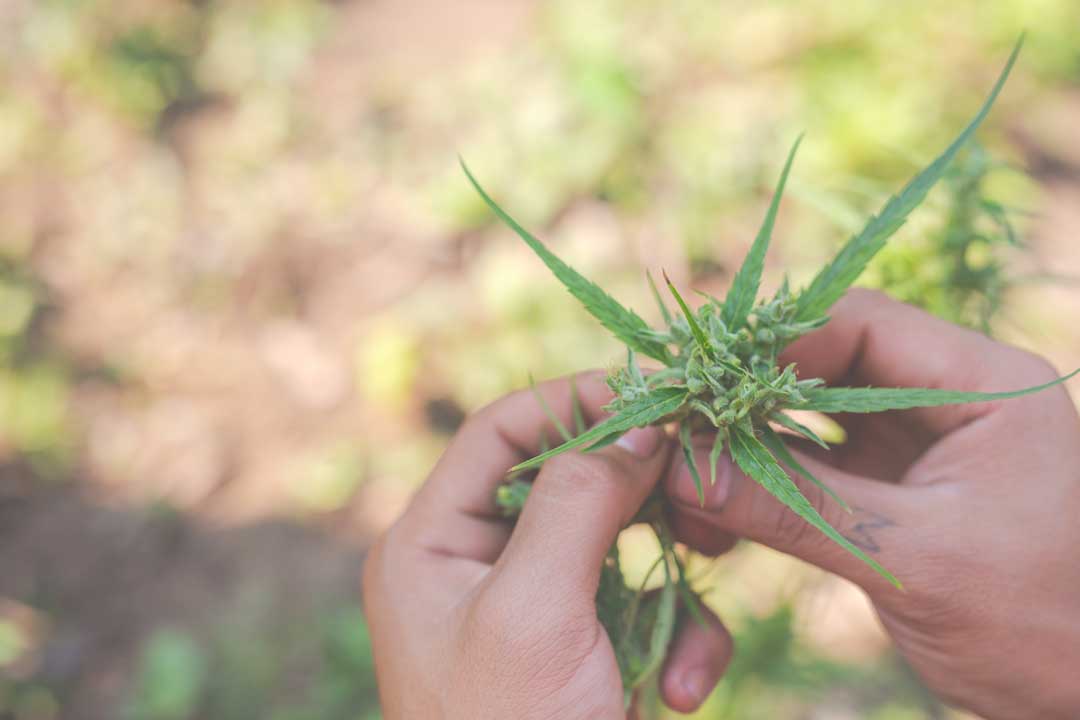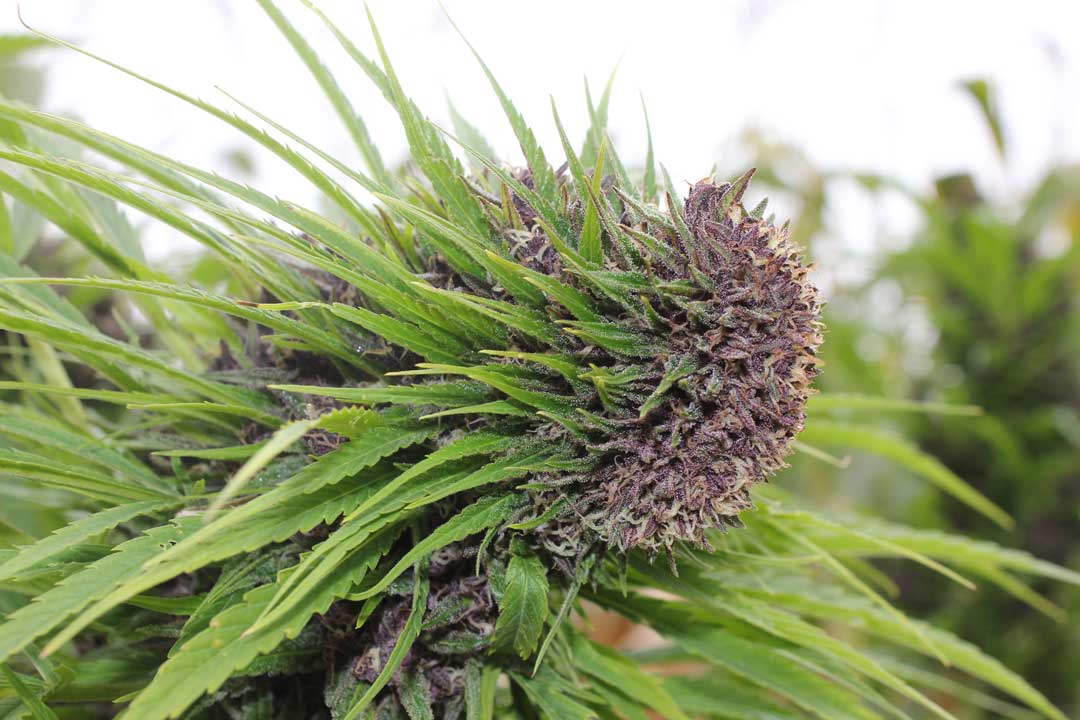Top 11 most common cannabis plant mutations

Most of the cannabis seeds you grow will produce fundamentally similar-looking plants. But from time-to-time you may see cannabis mutations. These can take the form of unusual colour, leaf structure, growth patterns and other strange features. Cannabis mutations can be seen when growing either autoflowering cannabis seeds or photoperiod feminised seeds. Here are some of the most common mutations you are likely to see.
Twin cannabis seedlings

Occasionally a cannabis seed will produce two seedlings from the same seed. This is one of the more common mutations that you may come across, but some strains such as Auto Think Different are somewhat more prone to twins than other strains.
The experienced grower can carefully try to separate the two seedlings, paying great attention to avoid root damage when doing so. Alternatively, many growers simply leave the twin cannabis seedlings to grow next to each other. Often you will get good results, though the grow may benefit from some training to optimise light spread / penetration and perhaps a larger plant container to accommodate two combined root balls.
Tri-Leaf cannabis seedlings

Some cannabis seedlings produce three, rather than the normal two, leaves. Tri-leaf cannabis seedlings often grow out of their tri-leaf tendencies as the plant ages and ripens during bloom.
Tri-leaf cannabis is also known as whorled phyllotaxy. Affected plants tend to be bushier than normal. It’s a mutation that most growers are likely to see at some point, though the trait doesn’t confer any benefits to growers, nor does it hold great interest from cannabis seed producers.
Ducksfoot or webbed cannabis leaves

Ducksfoot is a cannabis mutation which causes the normally separated fingers on the cannabis plant to melt together. The resulting leaf shape resembles the shape of a duck footprint. Without the iconic cannabis leaf shape, you can walk straight past a ‘Duck’ cannabis plant and never realise that it’s weed, especially during veg growth.
Such a mutation is particularly valuable to outdoor cannabis growers, or ‘guerrilla’ growers. Dutch Passion have two ‘Duck’ cannabis strains, both with this stabilised natural mutation. Frisian Duck is available in photoperiod feminised cannabis seeds. It uses genetics from the outdoor champ Frisian Dew hybridised with Ducksfoot genetics. She is normally ready to harvest around early October (northern hemisphere) or early April (southern hemisphere). Frisian Duck can also be grown indoors, taking around 8 weeks to bloom. Auto Duck is the autoflowering seed version, taking around 3 months to grow outdoors or ~75 days indoors.
Albinism and cannabis variegation

One of the most strikingly impressive cannabis mutations is variegation. This can take different forms, with white streaks in the leaves. Sometimes the leaves may be split half green and half white, some growers have reported green/bronze combinations. Although visually impressive, the lack of the green pigment chlorophyll means that photosynthesis is compromised, inferring lower yields.
Albinism is a cannabis mutation where the seedling produces no chlorophyll at all. Usually, the seedling dies within a few days after the cannabis seed germination.
Creeper cannabis

Creeper cannabis is a mutation most often seen with lanky sativa strains growing in warm, tropical climates. Occasionally branches may reach down and grow along the ground. Sometimes root sites will form at the contact point with the ground.
Usually only seen by outdoor cannabis growers, creeper cannabis has attracted little commercial interest from breeders and has limited uses from the grower’s perspective.
Australian bastard cannabis

Australian bastard cannabis or ‘ABC’ is thought to have originated in Australia in the 70’s. Like Ducksfoot, the leaves have a natural mutation with a shiny shrub-like leaf appearance and no serrations. This gives a natural disguise to the plant. Unfortunately, Australian bastard cannabis is low in cannabinoids and despite some interest from breeders there have been no stabilised, high-THC cannabis seeds made from ABC genetics.
Vine-like cannabis

One of the more mysterious cannabis mutations, the origins of vine like cannabis are unknown but may be a result of cross breeding with Australian bastard cannabis. Vine-like cannabis grows in an elongated fashion but is low in cannabinoids. So far there has been little interest from the cannabis seed companies to develop / stabilise vine cannabis.
Cannabis leaf buds

Another weird cannabis mutation which always dazzles the home grower is the formation of leaf buds. These often form at the base of the leaf, where the leaf and its stalk meet. It’s a fascinating change from buds forming on the main blooms. However, the cannabis leaf buds do little to enhance yield. Some growers remove leaf buds to allow leaf biochemistry to function along more normal lines. But plenty of other growers enjoy leaving them in-situ and showing them to their friends!
Polyploidism

Polyploid cannabis is a topic of significant interest to cannabis growers and breeders since it holds certain attractions in terms of potential increases in both yield and potency. Normally cannabis chromosomes come in pairs, one from the male and one from the female parents. Triploid cannabis has 3 sets of chromosomes, tetraploid cannabis has 4 sets of chromosomes.
The world’s most common banana is a triploid, deliberately incapable of forming seeds the yield of fruit is greater (who wants seeded bananas?) and growth is more consistent. The banana plant is propagated only by taking cuttings. Polypolidism is common within the plant world though less common in animals.
Polyploid cannabis is likely to be available at some point in the future. If (or should we say ‘when’) it happens, cannabis growers will be in for some serious bonuses and who knows, more potent buds and heavier yields. Watch this space.
| Related: |
| Polyploid Cannabis. What is polyploid cannabis? |
Foxtailed cannabis

Foxtailed cannabis, sometimes called a second-internode bloom, is where cannabis buds are produced in thin protrusions often just a calyx or two-wide. Without doubt it’s one of the prettier cannabis mutations, especially when the buds have a greasy layer of sparking trichomes. However, it does little to add significantly to yield.
Missing growth tip on the cannabis plant

One other unusual cannabis mutation which you may see is a missing growth tip from your cannabis seedling. These are rare and there is little you can do to return your plant to normal growth. You have two options, one is to simply get rid of the plant. The other is to keep it and hope that the lateral growth shoots (side branches) make up for the (eventual) lack of a traditional central bloom.
Final thoughts on genetic mutations in cannabis
Much of the time, growers see mainly consistent plants with few, if any, cannabis mutations. The best of the cannabis seed companies pride themselves on fully stabilised back-crossed genetics that deliver predictable and consistent performance for the grower. However, if you do see a cannabis mutation it can add some variety and extra interest to your grow.
| Related: |
| Cannabis plants anatomy from seed to trichomes |







































Rick Misterly
2023-05-22 18:22:48
Over the years I’ve had a few whorled phylotaxy plants that eventually grew out of it. But last year a female carried through all the way to harvest yielding one third more. Is there any disadvantage in trying to perpetuate this mutation?
GrowingBeansSorta
2023-04-11 10:26:48
I have a mutated purple punch og autoflower that I'm curious if anyone could take a look at. It's an interesting one so far. .. ....